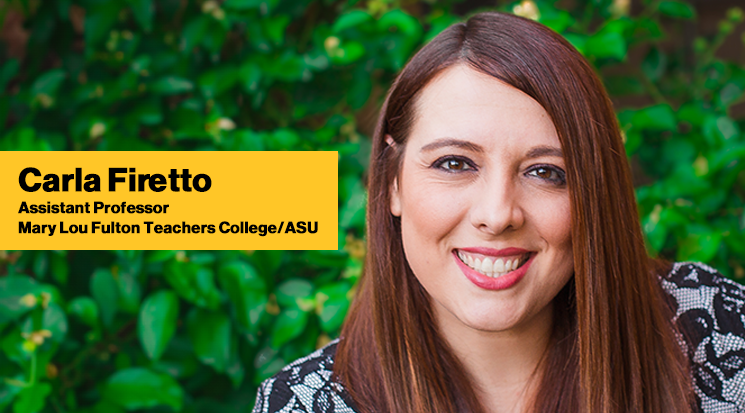Assistant professor researches STEM learning strategies for students and teachers

Recent technological advances in artificial intelligence, alternative energies and other math and science-related fields are profoundly shifting society and creating new opportunities in STEM-focused research and careers.
In support of these developments, researchers are identifying ways to make science, technology, engineering and math subjects more accessible to students and educators. Carla Firetto, an assistant professor of educational psychology at ASU’s Mary Lou Fulton Teachers College, is the lead author of two recently published papers that collectively offer insight into approaches that support student learning and engagement across a continuum of learning experiences.
Through her research, Firetto explores how to support effective learning and study strategies among students taking entry-level STEM classes. She also identifies ways to help K–12 educators strengthen their abilities to teach complex STEM subjects through the use of small-group classroom discussions. The two papers, summarized below, build on her research and interest in supporting learner engagement by providing a better understanding of the cognitive processes of learning across a wide range of contextual situations.
Effective study strategies in an introductory science class
Can a short online module on study strategies benefit students taking STEM courses? The impact of effective study strategy use in an introductory anatomy and physiology class, published in Frontiers in Education, examines this approach.
“Introductory biology courses often act as a gateway for students seeking careers in healthcare and science-related fields, and that’s why we need to find ways that support students’ learning of this foundational content,” says Firetto. “The purpose of this study was to see if a short module would encourage students to learn about and use research-based strategies to support their study efforts.”
For the research, Firetto and her colleagues designed a study that tested the extent to which students in the introductory anatomy and physiology course benefited from a brief online module about effective study strategies. About 100 participating undergraduate students took the module halfway through the semester. The module introduced students to six study strategies that have been largely established as effective in the broader education research literature. Students then completed questionnaires to assess whether they were using these approaches (for example, strategies such as flashcards or drawing pictures of anatomy elements).
The researchers used a coding process, detailed in the study, to evaluate the impact. Modest improvements were found in students' reported study strategy use over time, and students who reported an increased use of effective strategies also tended to demonstrate an increase in their exam scores. Further research, according to the authors, could provide additional insight into the efficacy of the module, as well as explore the benefits of the module for students who take these courses with less prior math and science experience.
The paper’s contributors include Emily Starrett (Learning, Literacies and Technologies, PhD, ’24), Lin Yan (Learning, Literacies and Technologies, ’25), and Amy Collins Montalbano, an assistant professor of mathematics at Northwest Vista College. Faculty from ASU’s College of Integrative Sciences and Arts also contributed to the paper: Tonya A. Penkrot, assistant teaching professor; Jeffrey S. Kingsbury, who is a teaching professor and associate dean of career track faculty success; and Jon-Philippe K. Hyatt, associate professor.
STEM teachers’ engagement in small-group discussions
For the second paper, Firetto and colleagues explored whether having in-service science teachers engage with each other in small-group discussions could help better prepare them for teaching and facilitating classroom discussions on these science-related topics.
Embracing a culture of talk: STEM teachers’ engagement in small-group discussions about photovoltaics, published in the International Journal of STEM Education, explores using small-group discussions as a way to support in-service K–12 teachers' understanding of and teaching about solar energy and photovoltaic science.
Participating teachers were learning about solar energy engineering and photovoltaic science as part of a larger, NSF-funded research experience for teachers (RET) program where they worked with ASU STEM faculty and completed a solar engineering research project. Firetto developed the research with her co-authors, MLFTC’s Emily Starrett (Learning, Literacies and Technologies, PhD, ’24) and Michelle E. Jordan, associate professor.
The researchers documented teachers’ engagement in a series of small-group discussions over the first two weeks of the five-week research experience. The teachers read articles and watched videos related to foundational concepts of solar energy engineering and photovoltaic science, then they met in small groups for 20-25 minutes to review and discuss what they had learned. The researchers found that teachers demonstrated increased content knowledge and self-reported greater capability to facilitate discussions in their future classrooms. Follow-up interviews indicated that several of the teachers reported greater subsequent use of discussion in their STEM classrooms in the year after the program.
“These findings indicate that small-group discussions among educators can help strengthen not only their STEM understanding and content knowledge but also help them to incorporate small-group discussions into their classroom learning environments,” says Firetto.
Other examples of STEM-related research led by MLFTC faculty:
- Tara Nkrumah, assistant professor: Black girls as creators: an intersectional learning ecosystem toward gendered racial equity in artificial intelligence education
- Antonio Duran, assistant professor: Fostering identify-affirming STEM at HSIs
- Brian Nelson, professor: Accessible Computational Thinking in Elementary Science Classes within and across Diverse Cultural and Linguistic Contexts